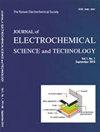从印刷电路板废弃污泥中回收铜:多级电流电解和建模
IF 2.2
4区 工程技术
Q3 ELECTROCHEMISTRY
Journal of electrochemical science and technology
Pub Date : 2022-02-07
DOI:10.33961/jecst.2021.00815
引用次数: 0
摘要
从印刷电路板工业废水中回收重金属是至关重要的,因为它具有成本效益和环境友好性。在本研究中,从印刷电路板生产的污泥中采用了酸浸和LIX 984N萃取的顺序工艺与电积技术相结合的铜回收路线。使用的剩余污泥来源于河内城市环境一成员有限公司(URENCO)。将从含有19.2g/L的高铜浓度和少量铁(0.575ppm)的印刷电路板废污泥中提取的溶液用作后续电解过程的电解质。通过使用多步电流电解的模拟模型,确定了电解时间间隔为30分钟的合理电流密度,以优化铜回收的比消耗能量。建立了数学模拟模型,计算了该过程的重要参数。本文章由计算机程序翻译,如有差异,请以英文原文为准。
Copper Recovery from Printed Circuit Boards Waste Sludge: Multi-step Current Electrolysis and Modeling
Heavy metals recovery from Printed Circuit Boards industrial wastewater is crucial because of its cost effectiveness and environmental friendliness. In this study, a copper recovery route combining the sequential processes of acid leaching and LIX 984N extracting with an electrowinning technique from Printed Circuit Boards production’s sludge was performed. The used residual sludge was originated from Hanoi Urban Environment One Member Limited Company (URENCO). The extracted solution from the printed circuit boards waste sludge containing a high copper concentration of 19.2 g/L and a small amount of iron (0.575 ppm) was used as electrolyte for the subsequent electrolysis process. By using a simulation model for multi-step current electrolysis, the reasonable current densities for an electrolysis time interval of 30 minutes were determined, to optimize the specific consumption energy for the copper recovery. The mathematical simulation model was built to calculate the important parameters of this process.
求助全文
通过发布文献求助,成功后即可免费获取论文全文。
去求助
来源期刊

Journal of electrochemical science and technology
ELECTROCHEMISTRY-
CiteScore
6.30
自引率
8.10%
发文量
44
期刊介绍:
Covering fields:
- Batteries and Energy Storage
- Biological Electrochemistry
- Corrosion Science and Technology
- Electroanalytical Chemistry and Sensor Technology
- Electrocatalysis
- Electrochemical Capacitors & Supercapcitors
- Electrochemical Engineering
- Electrodeposition and Surface Treatment
- Environmental Science and Technology
- Fuel Cells
- Material Electrochemistry
- Molecular Electrochemistry and Organic Electrochemistry
- Physical Electrochemistry
- Solar Energy Conversion and Photoelectrochemistry
 求助内容:
求助内容: 应助结果提醒方式:
应助结果提醒方式:


